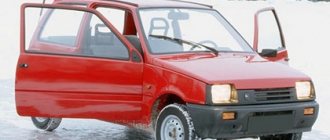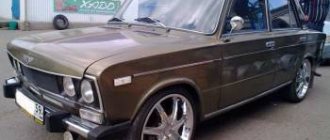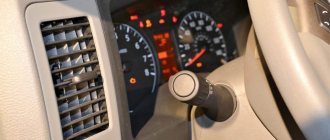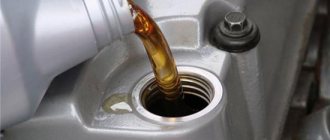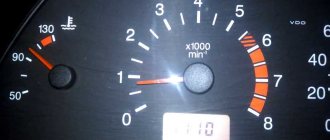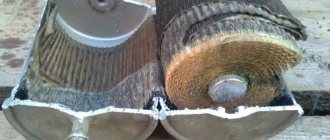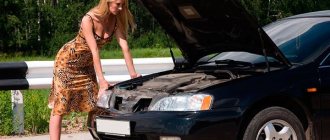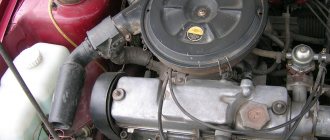Some drivers have noticed that after warming up the engine begins to stall, that is, its power drops due to a malfunction of one of the internal combustion engine cylinders. In addition to a noticeable deterioration in speed characteristics, as the speed increases, you can notice body vibrations, significant fuel consumption and a variable number of idle speeds. Where this problem comes from and how to solve it needs to be clarified.
About engine tripping
The term “troit engine” appeared in the Russian language when citizens began to use cars with a 4-cylinder engine. If any of the 4 cylinders stopped working properly, they said that the engine was failing. Now the same designation is used even for 6- and 12-cylinder internal combustion engine models, although this is not an entirely accurate designation of the malfunction.
The peculiarity of the problem is that it is detected only after the engine is started and the parts are significantly heated.
During warm-up, internal parts may change their characteristics and dimensions, causing damage to occur while driving. Since 1 cylinder is malfunctioning, driving even short distances becomes unforgettable: body vibration in the first 2 minutes will already prove that the car is not capable of moving. However, tripling may disappear and then reappear.
Car exhaust system problem
The engine may also stall if the tubes responsible for removing gases are malfunctioning. At full speed, the car will quickly begin to “choke”, and pressing the gas pedal completely stops the engine. Malfunctions in the operation of the exhaust pipe system in 90% of cases are caused by contamination and clogging of the muffler. However, the catalyst may also fail.
In the first case, carefully clean the muffler and remove foreign objects from there. If there are problems with the catalyst, conduct a complete diagnosis of the exhaust system and replace this element.
car muffler
Spark plug
The main thing is that you cannot immediately determine why one of the cylinders failed. That is why even experienced car enthusiasts and experienced drivers can delve into the insides of their car all day long, but in the end they will not achieve any result. You have to check everything several times.
How can you speed up this procedure and pay attention to the most important problems. Most often, the engine stalls when warming up due to faulty spark plugs.
One of the causes of malfunction are spark plugs if:
- The contacts and insulation of the spark plugs are covered with oil or black soot.
- The spark plugs or their contacts are damaged.
The problem is this:
- excess oil enters the combustion chamber from the crankcase;
- the air-fuel mixture located in the combustion chamber does not ignite due to a faulty spark plug.
The solution to the problem is simple: you need to replace the entire set of spark plugs, and then check the remaining parts next to them for damage. Change the oil and start the engine. If the tripping has stopped, then everything has been done correctly; if not, we need to look for other sources of the problem.
Possible problem options
Further searching for the cause of the problem becomes more difficult, since you will have to check a dozen parts for damage:
- There is additional air leakage into the combustion chamber; you need to check the hoses and wiring.
- There is a breakdown somewhere in the wiring; you should check their insulation for damage.
- The problem is in the capacitors - check, replace if they are faulty.
- Inspect the valves for burnouts.
- Next, you need to inspect the pistons and their rings. If there are broken rings or burnt pistons, the problem may be with them.
That's all there is to inspect first. Next, you should go through and inspect the following parts for defects: carburetor, valve stem seals, valve rockers, air filter, entire ignition system, cylinder head gasket.
If it continues to malfunction after a detailed inspection of all parts and replacement of all damaged components, then you need to contact a service station for the help of specialists and computer diagnostics of the car. The cause of the malfunction is extremely difficult to find, so even finding it may take not several hours, but several days. In rare cases, even a trip to the service center may end in nothing.
How to check the wiring?
There is one, rather risky way to find the cylinder: disconnect the high-voltage cables from the running engine one by one. By disconnecting the power from the ignition, it will be possible to understand which of the cylinders is not working, thereby significantly narrowing the search.
However, there is a risk of electric shock. It is not fatal, but it is quite painful, so you need to take care of your protection. You can start working if you first put on rubber gloves and stand on a rubber mat. Then follow these tips:
- Turn on the engine, raise and secure the hood.
- One by one, you need to disconnect the cables from the spark plugs. You must hold on to the insulation, not the tip of the wiring; you must not touch the body while removing the live wiring.
- If you turn off the slave cylinder, you will hear that the sound of the engine running has changed. But if it is faulty, then nothing will happen.
List of possible problems
Problem. After filling up with new gasoline, the check engine light started to come on, the car managed to warm up, but it started to stall after about 20-30 minutes of driving. Answer. In this case, it is not the ignition; the power supply and gas distribution system can also be discarded. It is necessary to check the integrity of the carburetor and fuel supply system. Replacing gasoline sometimes does not solve the problem.
This happens in some foreign cars with automatic transmissions. If you can’t find anything on your own, you should go to a service station; computer diagnostics should reveal the problem. There is no need to agree to replacing components without a reason, if the option will only possibly solve the problem. It is recommended to visit another service station.
Problem. Gasoline engine, injection type, misfires are shown in different cylinders during diagnostics. The spark plugs were replaced, all parts of the gas distribution system were cleaned and checked. Answer. The breakdown may be in the distributor cover or the ignition power supply: wiring, coils. It remains to check the fuel system as well.
Engine tripping is a very unpleasant defect that is difficult to get rid of. It is necessary to check all the above components, replace damaged parts - perhaps this will solve the problem. If all attempts are in vain, then you should go to a service station for diagnostics.
Cars suffer many breakdowns during operation, and one of the problems that most often and most worries owners is why the car stalls and does not. Let's consider the main causes of such phenomena, as well as possible actions to prevent them.
Let's sum it up
Fine cars with carburetor engines have become industrial history, but they are still widely represented on the roads. That is why you can use the ideas presented in this publication, since there are still a lot of carburetor masters, and you can find the necessary spare parts in stores. If your car has problems with the quality of the fuel supply system, it’s time to fix all these problems. You can quite easily obtain high quality operation of the power unit and fuel system if you simply take care of all the important components of the car.
Cars with gasoline engines
A gasoline engine may not start after warming up quite often, especially when operating in low temperatures. The fact is that the fuel remaining in the chamber begins to evaporate quickly due to elevated temperatures. Vapors fill all cavities, including the carburetor, manifold, and air filter. As a result, fuel levels in the float chamber decrease and gas plugs occur. The duration of this process depends on the design of the fuel system and on the external temperature conditions.
That is, the reason why a gasoline engine does not warm up after warming up lies in excessive evaporation of gasoline and the formation of an enriched fuel mixture.
We carry out diagnostics and repair work on the carburetor ourselves
You can take advantage of excellent carburetor work if you know its design and have already dealt with simple repair processes. Otherwise, we do not recommend that you try recovery on your own. Ultimately, such repairs will cost much more than they could cost from specialists. If you have experience and confidence in your skills, you can use the advice of specialists to perform a high-quality restoration of your car. Among the main work that will have to be carried out, the following processes can be identified:
- remove the carburetor cover with the air filter and try to start the car, as it warms up, lower the choke and look at the position of the dampers, perhaps adjusting them will be enough to restore the car’s operation;
- if this does not help, look at the functioning of the fuel system; perhaps the fuel pump stops pumping fuel after a certain period of normal operation;
- also examine the cooling system, regardless of what the gauges on the dashboard say, look at the antifreeze level, make sure the thermostat is working correctly;
- you can also change the air and fuel filters to make sure that fuel and air enter the carburetor without problems and in sufficient quantities;
- the last stage of work is the removal and disassembly of the carburetor to install a repair kit, new gaskets, membranes and other parts, as well as to clean this device from contamination.
Cars with diesel engines: causes of malfunction and solutions
Considering the question of why a diesel engine does not start well after warming up, it can be noted that this problem when heating occurs among many owners of cars of all classes. Unlike a gasoline engine, the problems of a diesel engine are not so obvious and trivial.
This problem is common among domestic and imported cars. The reasons for this phenomenon, when the machine refuses to work, are varied:
- Problems with the fluid temperature control sensor. The sensor that records and displays information about the coolant temperature has failed, resulting in the fuel mixture being supplied incorrectly.
- If the electronic device does not function correctly or breaks down, it receives an incorrect impulse, the fuel supply adjustment is disrupted, and after warming up the engine does not start.
- Depressurization of injectors when heated, through which diesel fuel leaks over time. It is found in excess in the combustion chamber, which interferes with the normal operation of the engine. You need to take out the injector and see how wet it is.
- Incorrect operation of the fuel injection pump when heated; in diesel engines this element is often subject to malfunctions. The problem is solved by cooling the rear area of the pump and trying to start again, and the way out of the situation is to replace the plunger pair and bushings.
- Malfunctions of the injector sensors responsible for fuel injection. As a result, the injection angle changes; to solve the problem, it is necessary to correctly adjust the direction. It is recommended to check the operation of the idle speed and pressure regulators.
In fact, there are few common causes and problems of hot starting, and if you know the right solutions to eliminate them, you can avoid unforeseen consequences and make the driving process more comfortable.
Don’t immediately panic and go to a service station to find out why the car won’t start. Problems may lie in trivial things.
Why might the carburetor stall after warming up?
To understand the cause of this problem, it is best to contact motorists who have already encountered such a problem. Whatever happens to your car, remember that similar problems have most likely happened to other car owners. Therefore, you should visit specialized forums or simply chat with other motorists. In this case, you can find several options for answering your question. After warming up, the carburetor completely closes the choke valve, leaving the accelerator valve in working condition. If the idle speed is set incorrectly, the engine will only run on choke. But this is the basic reason; there are several other popular problems:
- rapid engine overheating and serious problems with the cooling system of your power unit;
- very poorly adjusted valves - adjustment has not been made for several years in a row;
- the carburetor is not adjusted, the mixture is too lean, the system blows too much air into the combustion chamber;
- the mixture can also be overly rich, which causes fuel overflow and problems in some carburetors;
- the carburetor jets are clogged, fuel flows poorly through them, which causes problems in the quality of the mixture;
- gasoline is incredibly bad, the filters are clogged, the flow rate of the fuel system has become much lower;
- Certain problems have arisen inside the carburetor, membranes and gaskets have broken, and fuel is leaking.
The latter case is especially popular on domestic cars. Due to improper operation of the fuel pump and other troubles, which may well become a problem in the functioning of the power unit, the carburetor simply stops working normally, its main functions are disrupted due to damage to internal parts. This is also one of the most difficult types of breakdowns, so you will have to invest a lot of time or money to solve this problem. Therefore, first you should check and eliminate other possible problems that could cause such troubles. In particular, you can check all the previous points, which could also cause the carburetor to perform poorly and stop functioning when hot.
Summary
On modern cars, if the engine is malfunctioning and stalls “hot” when heated, special sensors can signal malfunctions. If you do not understand their location or meaning, you must contact a service station.
The failure of the power unit to operate when cold or after warming up to a certain temperature may indicate a fairly wide list of possible problems. The engine begins to stall both suddenly and to work unstably in different modes, after which the internal combustion engine stops.
In this article we will talk about the reasons why the engine stops at idle, as a result of which a warm engine stalls, why a car with a hot engine stalls while driving, etc.
Read in this article
Common problems on all engines at idle
There are a number of problems that are typical for all power plant designs. Due to the design features of internal combustion engines, at idle speed, malfunctions and interruptions in operation stability may occur.
Problems with carburetor engines
- Idle jet clogged. When using low-quality fuel, thin passages can become clogged with debris or grains of sand, which causes unstable engine operation.
- Low permeability of air and fuel lines. If there is insufficient amount of fuel or oxygen, the power plant does not hold idle well and may stall.
- Incorrect ignition setting or system problem.
Why does the injector stall at idle?
The injector is characterized by the presence of factors:
- incorrect operation of the computer;
- clogged injectors;
- failure of individual sensors.
Diesel won't idle
They are capricious due to the following reasons:
- problems with the injection pump system;
- insufficient purity of diesel fuel;
- breakdowns within the fuel or air line system.
They may stall in winter due to fuel freezing.
A hot engine stalls while driving or idling
Let's start with the fact that the symptoms and signs of this problem can manifest themselves in different ways. Quite often, the power unit may stall in idle mode, and unstable operation and complete stop of the internal combustion engine often occurs after the engine has warmed up.
First of all, diagnostics should begin with checking the spark plugs and their condition. At the same time, high-voltage armored wires should also be checked. This must be done because there may be weak sparking or no spark at all on the spark plug electrodes. Interruptions in the spark lead to serious malfunctions in the operation of the engine, as a result of which both the cold unit and the engine stalls after warming up. Replacing spark plugs and high-voltage wires often helps solve the problem.
Another common situation is when the engine stalls hot or cold immediately after starting it. In this case, on many modern cars with an injection power system, you should check the idle speed sensor. The failure of this element of the electronic engine control system often leads to the fact that the engine is simply unable to operate at idle speed.
Fuel supply faults
It is quite easy to find out that the car stalls while driving due to the engine being “choked” with the fuel mixture - during a long drive you will find that the signal of the sensor responsible for this function is constantly on.
Here the problem lies in low-quality fuel, which does not quickly “ignite” from the spark of the candles. It can also be caused by gasoline not meeting the requirements for the octane number specified in the vehicle specifications. If there are problems with fuel, the gas pedal will be pressed all the way, and the car will not begin to gain speed. In addition, the car will periodically stall when the clutch is engaged.
Another symptom indicating problems with fuel is the appearance of problems with the car after refueling. The problem is characterized by a rapid drop in engine power at full speed, as well as when constantly changing gears. The way out of the situation is to completely drain the bad fuel mixture, wash the engine and all the fuel system pipes.
Also, the car will constantly stall if there is an interruption in the supply of the fuel mixture. This may be due to contamination in the following system components:
- Dirt in the fuel filter;
- Problems with injector nozzles;
- Dirty throttle valves;
- Fuel pump power failure.
The main symptom of a malfunction of these parts is that there will be a gradual drop in the power of the car’s engine, after which the car will stall even after sharply pressing the gas pedal. If you do not release the clutch carefully when changing gears, this will also cause the engine to stall.
The contamination of the fuel filter and fuel pump can be judged by the unstable operation of the machine even during idling and during rapid braking (when the supply of the fuel mixture decreases). And if the performance of fuel filters can be easily established during an external inspection and eliminated by replacing them, then to detect other causes, you need a full-fledged computer diagnostics, which can only be carried out in a car service center.
Another reason for a stalled car associated with the operation of the fuel pump is boiling gasoline in the fuel pump. This happens mainly in hot weather when the car is moving slowly or standing on the highway in traffic jams. The car will start to stall while driving, but when you turn on the idle speed and press the clutch, it will start again.
If boiling occurs, it is better to stand in a traffic jam with the engine turned off and gradually cool the car. After 5-10 minutes, the car's operation will be stable again.
Advice: if you recently did a wheel alignment with your own hands on a VAZ-2107, then to cool the car, proceed as follows - throw a piece of cloth made of dense material over the fuel pump body, which you first moisten with cold water.
Other reasons why the engine stalls when hot
In addition to the above material, I would like to note a number of malfunctions that lead to a sudden stop of a hot engine while driving. The unit may stall while driving if the timing belt or chain is broken. This situation means that in most cases the power unit will require expensive repairs, since as a result of a break the valves are bent, piston defects and other damage to engine elements occur.
If the engine stalls while driving through deep puddles or other water obstacles, then there is a high probability of water getting into the cylinders or the elements of the ignition system getting wet. In the first case, water enters the combustion chambers through the air intake. Since water is incompressible, the engine is severely damaged, connecting rods bend, cracks appear in the cylinder block, etc. After a water hammer, there is usually a need to overhaul the engine. In the second case, the problem is not critical, since after removing the moisture, the functionality of the ignition system and power unit can often be restored.
Also, a car may stall when hot if there is too little fuel in the fuel tank. Quite often the engine stops when driving uphill. The fact is that during a long climb, the car is in a position for a long time when the fuel tank is tilted and the fuel level is not enough to supply through the fuel intake. It is quite obvious that in this case the engine will stall.
